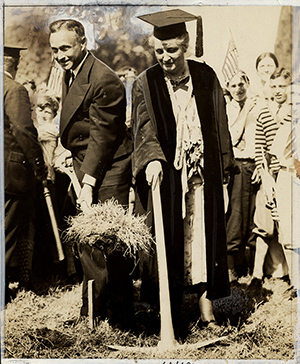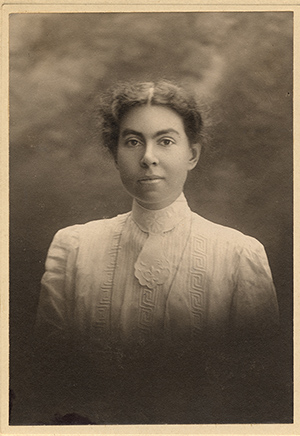Martha Tracy and the Tallant Affair
The Tumultuous 1920’s and the Tallant Affair
In 1921, Tracy as Dean faced another crisis: Woman’s Medical College (WMC) was on the verge of bankruptcy. Two years later, spurned by financial instability, the college experienced a “near suicidal internal conflict”: the Tallant Affair. There were two major players in the Tallant affair: Alice Weld Tallant, Professor of Obstetrics at WMC, and Sarah Logan Wister Starr, President of the Corporation of WMC. While Martha Tracy was not a direct player in the Tallant Affair, her role was of crucial importance. That she chose to side with Sarah Logan Wister Starr and the Corporation was to have long ranging impact on the internal politics of WMC.
Who was Alice Weld Tallant?
Tallant was born in 1875 and held a Bachelor’s degree from Smith College and had completed graduate work at the Massachusetts Institute of Technology before graduating with an M.D. from Johns Hopkins in 1902. She had a long list of accomplishments. She had had spearheaded a number of “child saving” campaigns during the Progressive Era of the late 19th and early 20th century, been awarded a Croix de Guerre for her medical service in France during World War I, and authored Textbook of Obstetrical Nursing in 1922. She had taught Obstetrics at WMC since [1903] and was well respected by her professional peers and beloved by the WMC student body and alumnae.
On the business side of WMC stood Sarah Logan Wistar Starr. Starr was appointed President of the Corporation of WMC in 1921, and came from a moneyed and established Philadelphia family.

Dr. Sarah Logan Wister Starr, President of the WMCP Corporation.

Dr. Alice Weld Tallant, Professor of Obstetrics at WMCP until 1923.
In the Special Bulletin of the Woman’s Medical College, Starr explains her approach to stabilizing the suffering institution:

Special Bulletin of the Woman’s Medical College of Pennsylvania, June 1923. Page 2.
Starr’s platform of “strong, centralized executive control” resulted in WMC’s Board refusing to reappoint Alice Weld Tallant, Professor of Obstetrics and Chief of Inpatient and Outdoor Maternity Work, in what was to be her 20th year of service to the college.

Special Bulletin of the Woman’s Medical College of Pennsylvania, June 1923. Page 5.
Starr and the Corporation could not have made a more unpopular move. The decision not to reappoint Tallant led to a huge outpouring of support for Professor Tallant by WMC’s faculty, students, and alumna. By March of 1923, Frances C. Van Gaskin, Professor of Clinical Medicine and Alumna, lead the challenge of the Board by the Faculty. WMC students went on strike, and would not attend classes. On March 21st, 1923, 200 WMC Alumna signed a petition, demanding that the Board provide concrete reasons for Tallant’s not being reappointed. Further adding fuel to the fire, the Board refused to provide reasons for Tallant’s dismissal.

Special Bulletin of the Woman’s Medical College of Pennsylvania, June 1923. Page 4.
A month later, on April 4th, 1923, the Board voted to support the Executive Committee’s decision not to reappoint Tallant by narrow margin of 7 to 9. Faculty members began to fear the new atmosphere at WMC, and Francis C. Van Gasken wrote to alumna Mary Riggs Noble: Mrs. Starr says we are “old” and “they will replace us with new ones.” A few days after the Board’s vote, a number of senior faculty members began to resign. These included Ruth Webster Lathrop, Frances C. Van Gasken, Arthur Stevens, Harry Deaver, George Peirsol, and Berta Meine.

Special Bulletin of the Woman’s Medical College of Pennsylvania, June 1923. Page 8.
In June of 1923, some reason for Tallant’s dismissal from Starr finally came in the form of a published pamphlet entitled, Special Bulletin of the Woman’s Medical College of Pennsylvania (excerpted above). In response to the Special Bulletin, a meeting was called by alumnae on June 11th, 1923, “Emergency Committee of Protest of Alumnae of the Woman’s Medical College of Pennsylvania.” A dictated statement by Martha Tracy from this meeting provides insight to Tracy’s position on the Tallant Affair:
“We must not allow ourselves, I think, to be led into a discussion of Dr. Tallant’s professional attainments. No one can question them. Therefore, there is no argument.
(Applause)
I shall also add my word to Dr. [Clara] Marshall’s that Dr. Tallant has done very much,- and probably more than any other one on the faculty in technical work on schedules- but in this hospital this situation has arisen and it is a matter of administration in which I am convinced the Executive Committee is acting wisely and for the best interests of the institution.”
While Dean Tracy’s siding with Starr was an unpopular stance, they were joined by few others. These included Walter Sheppard, WMC Board VP and counsel, Catherine MacFarlane, M.D., WMC Gynecology, Margaret Butler, M.D., WMC Otolaryngology, and Eleanor Jones, M.D., WMC Pediatrics. While surely each had their individual reason’s, Tracy’s above statement from the “Emergency Committee of Protest of Alumnae” meeting seems evidence that, no matter the price, the continuation of WMC’s legacy as a female medical college was of paramount importance to her. And because of, or despite of, Tracy’s solidarity with Starr and the corporation, WMC survived as an institution, and was able to educate many more generations of women in medicine.
Back to Top